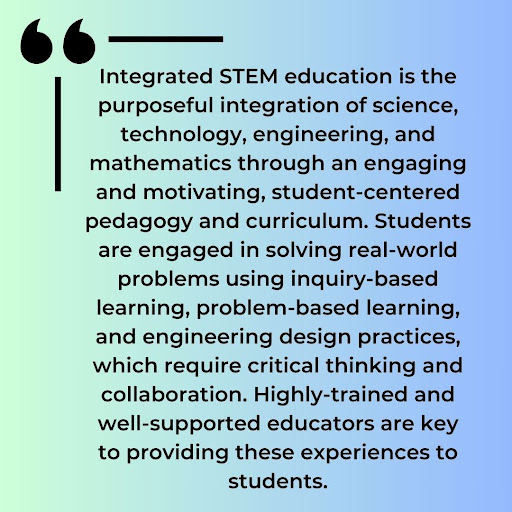Welcome to the final installment of this ongoing discussion of integrating STEM at all grade levels! Previously, I’ve discussed how natural curiosity can be encouraged and strengthened in early elementary students, how upper elementary students can be deeply invested in authentic problem solving, and how to make the most of the middle school transitions to enhance engagement. In this post, I’ll take on the challenge of interdisciplinary teaching and collaboration in high school.
As a former high school teacher myself, I know how particular high school teachers can be. We can become so focused in our content areas, graduation requirements, and living bell-to-bell that we can be skeptical of new initiatives, information from non-secondary folks, and anything that requires (gasp!) collaboration across disciplines.
So how do you get buy-in from both high school faculty and students? This is where we refer back to my personal favorite definition from Indiana’s Priorities for STEM Education.
I’ve seen so many digitally-focused assignments in high schools lately, utilizing the myriad online platforms and programs available today. I worry those instant-feedback assignments are not supporting the research-based “engaging and motivating, student-centered pedagogy” that truly engages students. What about bringing back classroom discussions? Debates? Pro vs con lists?
I have no qualms stating that I’m a science nerd. And a fact nerd. I listen to podcasts called The Weirdest Thing I Learned This Week and Lateral to learn weird and unusual facts about the world. In my classroom, I love taking a few minutes away from content to discuss weird facts or current events or something I just learned about. Sometimes these connected to the chemistry we were learning, sometimes science in general, and sometimes it was something that wasn’t based in science at all. I often referred to it as “Blaske’s Random Fact of the Day”, building it in to bell-ringer questions, using it as a brain break during a long class period, or including it as part of class discussions or assignments to prompt interdisciplinary thinking. I do think it helped develop my relationship and classroom culture with my students, got them thinking about the world around them, and (maybe most importantly) showed them an adult who was still really excited about learning. This opened up a great dialogue among my students and I, especially when they have questions about something they’ve seen or heard on the internet or social media. I didn’t have to work hard to build this into my routine; I just kept a list of things I’d read or heard on my phone that I could reference when needed.
I was also honored to have been able to teach a course for a short period of time called Science and Society. My school used the Indiana Department of Education Nonstandard Course Waiver process to offer this one-semester course where we read, discussed, and wrote about current events related to STEM. While I always had a syllabus of topics laid out, we would often interrupt the schedule to watch the news during a natural disaster or analyze video footage to determine the validity of a new record or challenge. Students developed skills in critical thinking, public speaking, non-fiction reading and writing. This was an amazing opportunity for both myself and those students who were able to take the course. With new STEM requirements for Indiana High School Diplomas, this could be an option for some schools. But for those schools who cannot run an entire course, these same skills can be integrated into any course, including but not limited to STEM courses.
- The day after a test, students read a news article that relates to the content you just covered.
- You integrate a “Current Event Tuesday” into your course weekly or biweekly.
- Keep an editable file “weird facts” to talk to your students about and get them asking questions. Time these to relate to your content or even content they are learning at the same time but in a different course. Some “high quality” YouTube, Tiktok, or Instagram accounts could be a great starting point.
- Take one lesson/project and “modernize” it
- Based on current laws, what crimes would the characters in Macbeth be able to be indicted of?
- Have students collect information from classmates on their income from after-school jobs to determine an equivalent employment rate, average income, etc. for the school, rather than the nation.
- How would the writing of the Constitution have been different if the Founding Fathers had cell phones?
“Integrating STEM doesn’t have to only be in science class, it’s really all about providing students with opportunities to think deeply, solve problems, use evidence, and share their results with others.”
The Uncomfortable Part
In my time as a high school teacher, as well as conversations with my friends and former colleagues who still work in high school, the pressures of covering content, preparing students for college and career, and many other requirements often challenged feelings of freedom or classroom autonomy. But taking advantage of five minutes a week, these ways of breaking students out of traditional thinking patterns and modeling strong questioning techniques can start to build the confidence and skills of students in critical thinking and communication. It can be so difficult when students in your class, especially in junior and senior years, have such varied experiences in the courses they take. Commonalities can still be found, but you might have to dig a little deeper.
I hope that educators of all levels have found something in this blog series to motivate, inspire, and include in your teaching next school year. Remember, these are just ideas for first steps; share your ideas with colleagues or friends, mix and modify as needed to fit the needs of your school and students. Integrating STEM doesn’t have to only be in science class, it’s really all about providing students with opportunities to think deeply, solve problems, use evidence, and share their results with others.
Resources
Please login or register to claim PGPs.
Alternatively, you may use the PGP Request Form if you prefer to not register an account.




